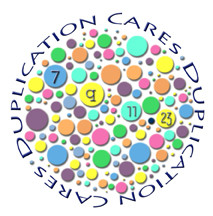7q11.23 Duplication Research
7q11.23 Duplication Syndrome Wikipedia Page
7q11.23 duplication syndrome (also called dup7 or Duplication of the Williams-Beuren Syndrome Critical Region) is a rare genetic syndrome caused by micro-duplication of 1.5-1.8 mega base in section q11.23 of chromosome 7. This Wikipedia article was first entered in June 2019.
7q11.23 Duplication Gene Review
Recently updated paper on 7q11.23 Duplication Syndrome by Carolyn B Mervis, PhD, Colleen A Morris, MD, Bonita P Klein-Tasman, PhD, Shelley L Velleman, PhD, and Lucy R Osborne, PhD. Created: November 25, 2015; Updated: March 25, 2021. National Center for Biotechnology Information, U.S. National Library of Medicine, National Institutes of Health. Article source: GeneReviews.
GeneReviews are expert-authored, peer-reviewed disease descriptions (“chapters”) presented in a standardized format and focused on clinically relevant and medically actionable information on the diagnosis, management, and genetic counseling of patients and families with specific inherited conditions.
NIH article documents a pain insensitivity mechanism arising from gene overexpression in individuals with the rare 7q11.23 duplication syndrome (Dup7). Based on parental accounts and pain ratings, triploid subjects with 3 copies at the Dup7 region, mainly children in this study, are pain insensitive following serious injury to skin, bones, teeth or viscera. In contrast, diploid siblings (2 copies) show standard reactions to painful events.
NIH article discusses pubertal timing, including age at menarche (AAM), a heritable trait linked to lifetime health outcomes. Study investigates genetic mechanisms underlying AAM by combining genome-wide associate data with investigations Dup7 and Williams Syndrome, two rare genetic conditions clinically associated with altered AAM.
Aggression in 7q11.23 Duplication Syndrome (August 2022)
Article by Bonita P. Klein-Tasman, PhD, Brianna D. Yund, PhD, Carolyn B. Mervis, PhD, 2022. Discussion of aggression and oppositionality in children with Dup7.
7q11.23 Duplication Physical Characteristics and Natural History
Documented and clinical research published on the medical and physical findings concerning 7q11.23 duplication
Aortopathy in the 7q11.23 microduplication syndrome
Documentation describing aortic dilation in 7q11.23 duplication individuals
Characterization of brain and behavior in 7q11.23 duplication syndrome
Osborne and her team have generated mice with duplications of eight genes from the critical region, as well as mice with a duplication of a single, important candidate gene, GTF2I.
Speech, Language, Cognitive, and Behavioral Characteristics, and their Implications for Intervention
Intensive speech/language therapy is critical for maximizing long-term outcomes.
Our findings confirm initial reports of speech delay seen in patients with dup(7)(q11.23) and further delineate and expand the phenotypic spectrum of this condition to include communication, social interactions, and repetitive interests that are often observed in individuals diagnosed with autism spectrum disorders.
Behavior Profile of DNA Disorder Reveals Ties to Autism
The findings, published 21 April in the American Journal of Medical Genetics, support the notion that genes within this surplus swath of DNA, called ‘Dup7,’ may contribute to autism symptoms.
Autism-linked genetic region affects size of brain structures
In the new study, researchers used structural magnetic resonance imaging to look at the size of brain structures in 19 children with Williams syndrome, 7 children with 7q11.23 duplications and 46 controls, all of whom have intelligence quotients in the normal range.
7q11.23 Duplication UNIQUE Pamphlet
The information in this guide is drawn partly from the published medical literature. The first-named author and publication date are given to allow you to look for the abstracts or original articles on the internet in PubMed (www.ncbi.nlm.nih.gov/pubmed). If you wish, you can obtain most articles from Unique.
Unstuck and On Target: An Executive Function Curriculum that Increases Flexibility and On-Task Behavior
WILLIAMS-BEUREN REGION DUPLICATION SYNDROME
The chromosome 7q11.23 duplication syndrome is a multisystem developmental disorder with variable manifestations, most commonly speech delay and mild craniofacial anomalies, and an increased incidence of congenital anomalies such as heart defects, diaphragmatic hernia, and cryptorchidism.
Our findings confirm initial reports of speech delay seen in patients with dup(7)(q11.23) and further delineate and expand the phenotypic spectrum of this condition to include communication, social interactions, and repetitive interests that are often observed in individuals diagnosed with autism spectrum disorders.
